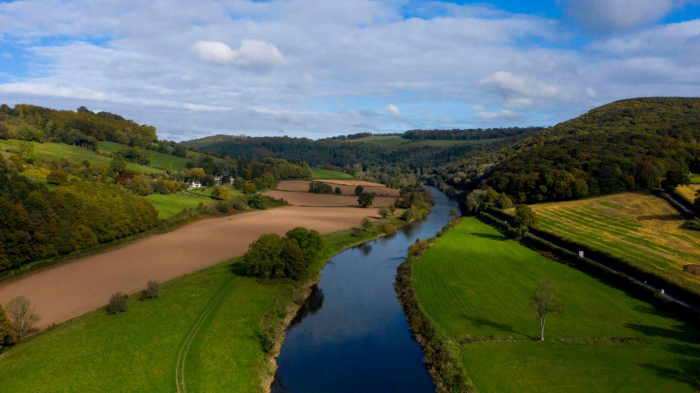Rivers are a surprisingly large source of greenhouse gases, and water pollution makes their emissions many times worse.
At first glance you would assume the New Territories were one of Hong Kong's greenest areas – the region that borders the Chinese mainland and makes up the bulk of Hong Kong's territory seems a world removed from the bustling streets and dense cluster of skyscrapers that tower over much of the city centre. By contrast, the New Territories are mostly rural and home to large swathes of farmland, rolling greenery, wetlands, mountains, parks and rivers.
On the surface, the New Territories appear to be Hong Kong's green lung, but the reality is rather more disconcerting. The rivers that snake through this lush landscape are in fact breathing out large quantities of greenhouse gases, according to a study of 15 of the area's waterways.
"All the river waters were supersaturated with the three main greenhouse gases, namely carbon dioxide, methane and nitrous oxide," says Derrick Yuk Fo Lai, a professor in the department of geography and resource management at the Chinese University of Hong Kong. Lai found that the concentrations of these gases were sometimes 4.5 times higher than the atmospheric concentrations.
The study, which assessed the impact of water pollution on greenhouse gas emissions in Hong Kong, indicated that rivers in the area are persistent sources of atmospheric greenhouse gases and could contribute to climatic warming. "We found that all our studied rivers would contribute to greenhouse gas emissions," says Lai. The team found that the more polluted the river was, the greater its emissions.
Discharge from livestock farms, misconnections in old buildings and unsewered premises were the main reasons for the pollution. In fact, the mean saturation levels of CO2, methane and nitrous oxide (N2O) in the more polluted rivers were about 2.2, 1.5 and 4.0 times, respectively, than those in the less polluted rivers.
"While the magnitude of carbon emissions from our rivers is small relative to that arising from fossil fuel combustion in our daily activities, their contribution to the total greenhouse gas budget of Hong Kong should not be ignored and should be minimised as far as practicable to mitigate future climate change," says Lai.
Microbial activity
The rivers in Hong Kong's New Territories region are not unusual in this regard. Surprisingly, rivers are a significant source of greenhouse gases globally.
It's estimated that rivers and streams release up to 3.9 billion tonnes of carbon each year (around four times the amount of carbon emitted annually by the global aviation industry). When you take into account the relatively small area taken up by rivers on the planet, that figure is remarkably large. In addition, it's estimated that aquatic systems like rivers and lakes contribute more than 50% to atmospheric methane, and global river N2O emissions have come to exceed 10% of human emissions.
The reason being, “rivers receive large inputs of carbon and nitrogen from the landscapes they drain”, says Sophie Comer-Warner, a biogeochemist and research fellow at University of Birmingham. “It used to be thought that rivers just transported these elements to the ocean, but we now know that they have high rates of biogeochemical reactivity.”
In other words, the various forms of carbon and nitrogen the microbes receive are broken down into other forms, usually through aerobic or anaerobic respiration, which release CO2 and may also release methane and N2O.
"To some extent rivers acting as a source of CO2 and other greenhouse emissions to the atmosphere is a natural part of the ecosystem," says Comer-Warner. "However, emissions are likely to become higher due to the condition or health of rivers."
For urban rivers in particular, higher emissions are becoming a growing problem. In some cases, urban rivers have been found to emit four times more than of the amount of greenhouse gases than rivers in natural sites.
One recent study assessed the emissions of CO2, methane and N2O from the Cuenca urban river system in Ecuador, and found a clear trend between water quality and greenhouse gas emissions: the more polluted the sites were, the higher their emissions. In fact, the study found that when river water quality worsened, its contribution to global warming can go up an order of magnitude.
"From our estimation, when rivers become polluted, their global warming potential (GWP) can increase from two to 10 times," says Long Tuan Ho, postdoctoral researcher at Ghent University, Belgium, and an author of the study. "When the river water quality deteriorated from acceptable to polluted, the concentration of CO2 and CH4 in the rivers increased tenfold while N2O concentrations were boosted by 15 times."
Ho and his team found that the increase of greenhouse gas emissions from rivers was also highly correlated to the changes in the land use and land cover surrounding the rivers. Particularly, the average CO2 and N2O concentrations of the sites close to urban areas were around four times higher than those of the natural sites while this ratio was 25 times in case of methane. "These findings highlight the impacts of land use and land cover on the production of greenhouse gases in the sites that were contaminated by sewage discharges and surface runoff," says Ho.
After entering the flowing freshwater bodies, pollutants such as nitrogen compounds and pollution from human activity are converted to greenhouse gases by microorganisms. Specifically, when dissolved oxygen in the rivers drops because of pollution, anaerobic bacteria mineralise organic matter to produce CO2 and methane while denitrifying bacteria converts nitrate (NO3) to nitrous oxide (N2O).
"These processes were verified in our research via the application of machine learning," says Ho. "In particular, dissolved oxygen, nitrogen compound concentrations, and river flow characteristics were identified as the main influential factors to the emissions of rivers."
Cleaner water, cleaner air
So the fact remains that rivers are being polluted by human activities, especially in urban areas, which is ultimately causing higher greenhouse gas emissions. It has been found that more than half of the world's population lives closer than 3km (1.8 miles) to a surface freshwater body, including river networks. This increased urbanisation has introduced a large number of contaminants to rivers as more than 80% of municipal wastewater is still directly discharged into the environment. Most of the pollutants come from untreated wastewater, agricultural runoffs, and increased sediment accumulation. This continues to cause urban polluted water bodies to become a significant hotspot for greenhouse gas emissions.
And it's predicted that greenhouse gas emissions from rivers are set to increase. "Given increasing urbanisation and the intensification of agriculture and aquaculture, the contribution of rivers to climate change in the future is likely to be much higher than the current estimation," says Ho.
However, there is hope that river restoration (including reducing pollution) will help to lower the rate of emissions.
"Our research implied that when water quality of the polluted rivers improved to good quality, the CH4 concentration found in the sites may reduce by 10 times," says Ho, "while the CO2 and N2O concentrations can decrease by four times."
So the results suggest that improving water quality really can make a significant difference. To that end, numerous programmes have been implemented to restore and rehabilitate rivers by reducing pollution, such as the EU Green Deal, EU Water Framework Directive, and Clean Water Act in the United States.
"These programmes have had tremendous positive impacts on improving river water quality, reducing flood risk, restoring habitat and increasing biodiversity globally," says Ho.
Meanwhile, Ho suggests that a range of prevention measures can all help to reduce pollution and in turn cut the rates of greenhouse gas emissions from rivers. Better wastewater treatment and increasing the number of wastewater treatment facilities, as well as introducing buffer corridors around rivers to reduce pollutant inflow, and reinstating natural channel shape and natural flow regime to avoid sediment accumulation, can all help to cut river emissions.
Similarly, back in Hong Kong, Lai who carried out the study which measured greenhouse gas emissions from 15 urban rivers, suggests that pollution could be reduced by minimising excessive use of fertilisers in agricultural fields and expanding the sewage network to even more rural populations. At present, about 6% of Hong Kong's population remain unconnected to sewerage systems, but the government is working to expand the network.
Currently, Lai and his team are finalising the results of their study, and like Ho, plan to share the findings to relevant governments and NGOs to inform them about the added benefits of improving the water quality of rivers.
"While the Hong Kong river quality in general has significantly improved over the last few decades, owing to various measures by the government (e.g. legislation, establishment of sewage network), there is still room for improvement, especially for rivers in Northwestern New Territories," says Lai. "Reducing the nutrient pollution in particular would not only improve the water quality for faunal activity, but at the same time help reduce greenhouse gas emissions and mitigate climate change."
BBC
More about:
















































